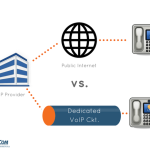Session Initiation Protocol is used to establish, change and tear down calls between one or more endpoints in an IP-based network. Similar to the HTTP (Hypertext Transfer Protocol) and SMTP (Simple Mail Transfer Protocol) that drives the entire web, SIP offers a flexible and common standard that can be leveraged to combine a vast variety of communications system and technologies. The advantages of moving to a SIP-enabled architecture extend beyond voice services.
SIP offers a set of unified communications through its open protocol – which makes it easier for vendors who supply all the different pieces to ensure the communication devices are all unified. Instead of a least common denominator implementation, SIP allows each user to take advantage of whatever features and functions are available on their particular device and network at any given time.
SIP trunking: The key to IT cost savings
Listed above are just features and benefits that users will realize. There’s lots to like about SIP also from an IT and cost perspective. One of the reasons is SIP trunking, which helps companies wring great efficiencies from the trunks they get from carriers.
Benefits of SIP trunking:
- Reduces calling costs and allows all calls to be turned into local calls
- Since calls travel over the Internet or through the VoIP phone system to a termination point, the charges on long distance calls are reduced
- Big (enterprise-size) or even small-sized businesses can all use a single SIP trunking account rather than having multiple PRI connections
- Significant cost saving from 20%-60%
While SIP can still empower your organization to leverage extensive communications capacities, the decision to make a transition to SIP should be well thought out and with careful consideration.
To learn more about AeroCom’s promotions and deals for SIP, click on the link below!
>>http://aerocominc.com/landing-pages/technology-of-the-month/<<






